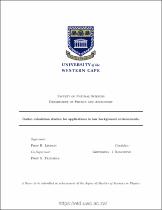| dc.contributor.advisor | Linsay, Robert | |
| dc.contributor.author | Goitseona, Ramonnye .J | |
| dc.contributor.author | Ramonnye, Goitseona. J | |
| dc.date.accessioned | 2023-04-18T12:17:58Z | |
| dc.date.available | 2023-04-18T12:17:58Z | |
| dc.date.issued | 2022 | |
| dc.identifier.uri | http://hdl.handle.net/11394/9808 | |
| dc.description | >Magister Scientiae - MSc | en_US |
| dc.description.abstract | Neutrinoless double beta decay (0 ) is a rare process that is yet to be observed. Observation of neutrinoless
double beta decays would imply lepton number violation, and that the neutrino is its own antiparticle (a
Majorana fermion). Understanding background contributions are important in searches for such rare nuclear
processes. This thesis details the design and operation of a radon detector in the context of low-background
deep-underground experiments, such as the one pursued by the nEXO neutrinoless double beta decay collaboration. | en_US |
| dc.language.iso | en | en_US |
| dc.publisher | University of the Western Cape | en_US |
| dc.subject | Astronomy | en_US |
| dc.subject | Physics | en_US |
| dc.subject | Cosmology | en_US |
| dc.subject | Radiation | en_US |
| dc.subject | Astrophysics | en_US |
| dc.title | Radon exhalation studies for applications in low background environments. | en_US |
| dc.rights.holder | University of the Western Cape | en_US |

